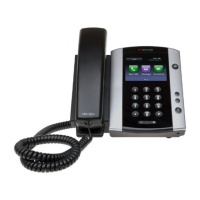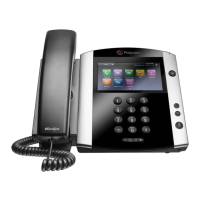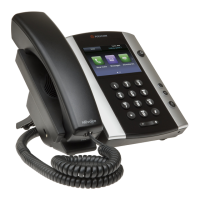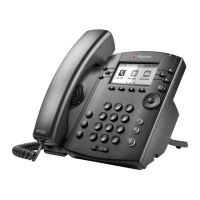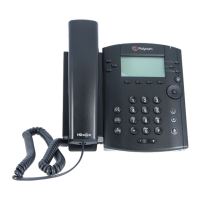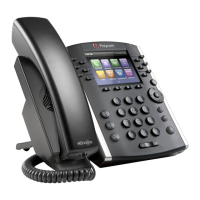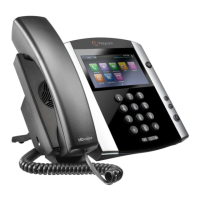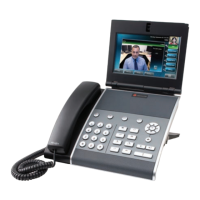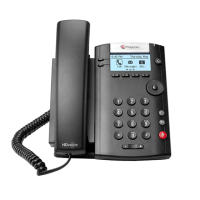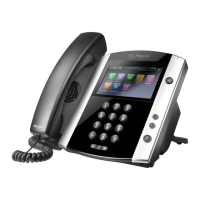











Do you have a question about the Polycom VVX 500 and is the answer not in the manual?
Describes the physical components and keys of the phone, including the dialpad and touchscreen.
Displays phone line and icons for accessing features, settings, and information.
Displays phone line(s), monitored lines, favorites, and soft keys; it is the default display.
Displays name, number, and duration of the active call for call management.
Displays all calls (active, held, incoming) for multiple calls or held calls.
Explains how to enter and edit data using the onscreen keyboard or dialpad keys.
Describes how to use the onscreen keyboard to quickly update field information.
Explains how to use dialpad keys to update field information instead of the onscreen keyboard.
Explains how to update phone settings remotely using the Polycom Web Configuration Utility.
Explains how the phone manages multiple calls and the different modes for placing/answering calls.
Details how to answer incoming calls using the handset, speakerphone, or headset.
Explains how to answer a second call while on an active call, holding the first call.
Explains how to manage multiple calls using Lines and Calls view.
Details methods for placing calls using handset, speakerphone, or headset, and dialing options.
Explains how to place calls from Recent Calls list, Favorites, or Contact Directory.
Details how to end calls using the handset, speakerphone, or End Call soft key.
Explains connecting and using analog, USB, and Bluetooth headsets with the phone.
Guides on enabling Headset Memory Mode for automatic headset use on all calls.
Explains how to turn on Bluetooth, pair, and connect Bluetooth headsets.
Detailed steps for pairing and connecting Bluetooth headsets with the phone.
Explains how to use a connected Bluetooth headset for calls, including muting and switching modes.
Explains options for responding to incoming calls: ignore, reject, or forward.
Guides on how to forward an incoming call to another person while the phone is ringing.
Explains how to place any active call on hold and how held calls are displayed.
Explains how to transfer calls, including blind transfers and instant transfers.
Guides on setting up conference calls with multiple parties and managing them.
Explains how to place conference calls on hold and how to resume them.
Details how to end a conference call and the effect on other participants.
Explains how to store and manage contacts in the phone's local Contact Directory.
Guides on changing the user password for phone access and security.
Explains how to lock the phone to prevent unauthorized calls and access to information.
Guides on choosing how to handle incoming calls when locked and unlocking the phone.
Guides on how to restart the phone for troubleshooting or to apply updates.
Explains how to update the phone's configuration remotely without restarting.
Guides on using the diagnostics menu to test phone hardware components.
Warns about electric shock and connecting SELV circuits to TNV circuits.
Describes the physical components and keys of the phone, including the dialpad and touchscreen.
Displays phone line and icons for accessing features, settings, and information.
Displays phone line(s), monitored lines, favorites, and soft keys; it is the default display.
Displays name, number, and duration of the active call for call management.
Displays all calls (active, held, incoming) for multiple calls or held calls.
Explains how to enter and edit data using the onscreen keyboard or dialpad keys.
Describes how to use the onscreen keyboard to quickly update field information.
Explains how to use dialpad keys to update field information instead of the onscreen keyboard.
Explains how to update phone settings remotely using the Polycom Web Configuration Utility.
Explains how the phone manages multiple calls and the different modes for placing/answering calls.
Details how to answer incoming calls using the handset, speakerphone, or headset.
Explains how to answer a second call while on an active call, holding the first call.
Explains how to manage multiple calls using Lines and Calls view.
Details methods for placing calls using handset, speakerphone, or headset, and dialing options.
Explains how to place calls from Recent Calls list, Favorites, or Contact Directory.
Details how to end calls using the handset, speakerphone, or End Call soft key.
Explains connecting and using analog, USB, and Bluetooth headsets with the phone.
Guides on enabling Headset Memory Mode for automatic headset use on all calls.
Explains how to turn on Bluetooth, pair, and connect Bluetooth headsets.
Detailed steps for pairing and connecting Bluetooth headsets with the phone.
Explains how to use a connected Bluetooth headset for calls, including muting and switching modes.
Explains options for responding to incoming calls: ignore, reject, or forward.
Guides on how to forward an incoming call to another person while the phone is ringing.
Explains how to place any active call on hold and how held calls are displayed.
Explains how to transfer calls, including blind transfers and instant transfers.
Guides on setting up conference calls with multiple parties and managing them.
Explains how to place conference calls on hold and how to resume them.
Details how to end a conference call and the effect on other participants.
Explains how to store and manage contacts in the phone's local Contact Directory.
Guides on changing the user password for phone access and security.
Explains how to lock the phone to prevent unauthorized calls and access to information.
Guides on choosing how to handle incoming calls when locked and unlocking the phone.
Guides on how to restart the phone for troubleshooting or to apply updates.
Explains how to update the phone's configuration remotely without restarting.
Guides on using the diagnostics menu to test phone hardware components.
Warns about electric shock and connecting SELV circuits to TNV circuits.
| Volume control | Digital |
|---|---|
| Display diagonal | 3.5 \ |
| Touchscreen type | Capacitive |
| Display resolution | 320 x 240 pixels |
| Caller ID | - |
| Lines quantity | 12 lines |
| Phonebook capacity | - entries |
| Bluetooth | No |
| Supported network protocols | FTP, TFTP, HTTP, HTTPS, IPv4, TCP, UDP |
| USB 2.0 ports quantity | USB 2.0 ports have a data transmission speed of 480 Mbps, and are backwards compatible with USB 1.1 ports. You can connect all kinds of peripheral devices to them. |
| Ethernet LAN (RJ-45) ports | 2 |
| Storage temperature (T-T) | -40 - 70 °C |
| Operating temperature (T-T) | 0 - 40 °C |
| Operating relative humidity (H-H) | 5 - 95 % |
| Handset type | Wired handset |
| Product type | IP Phone |
| Product color | Black, Silver |
| Compliance industry standards | IEEE 802.1p/Q, 802.1x |
| Number of handles included | 1 pc(s) |
| Harmonized System (HS) code | 85171800 |
| Depth | 180 mm |
|---|---|
| Width | 190 mm |
| Height | 150 mm |
| Weight | 900 g |
